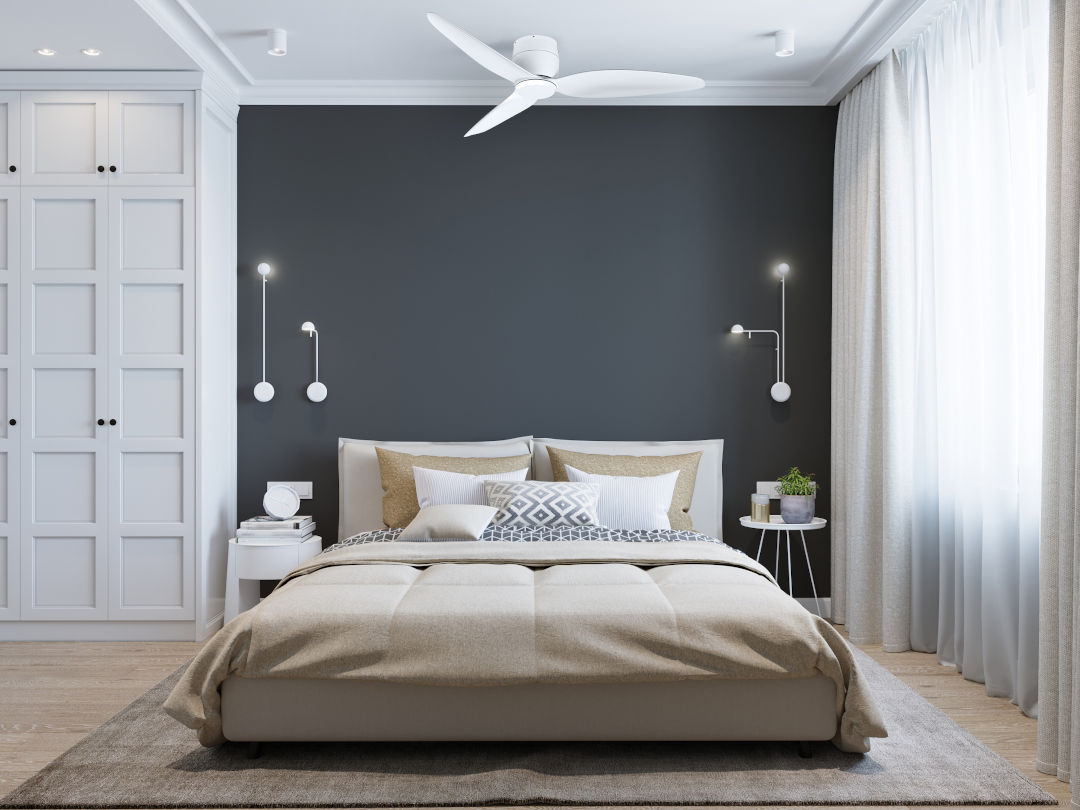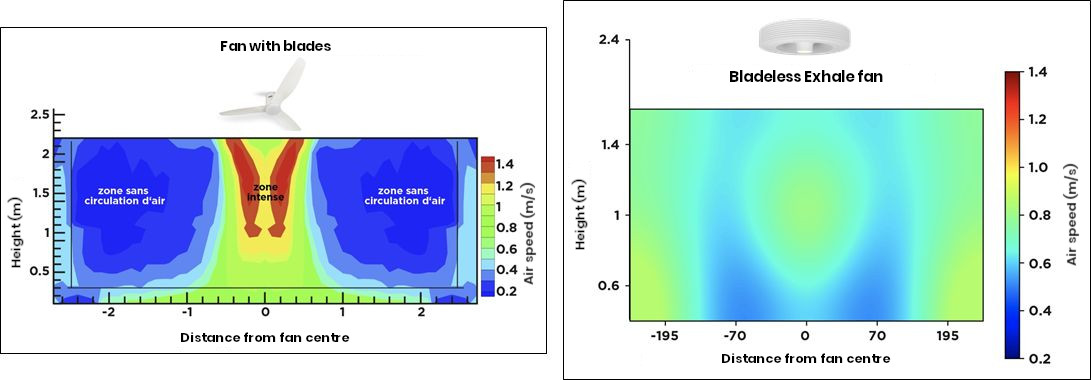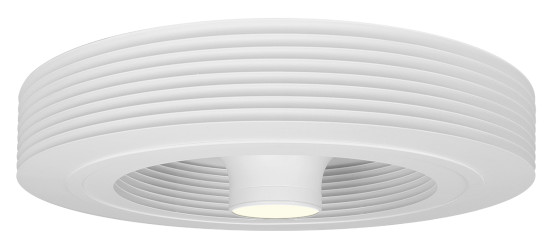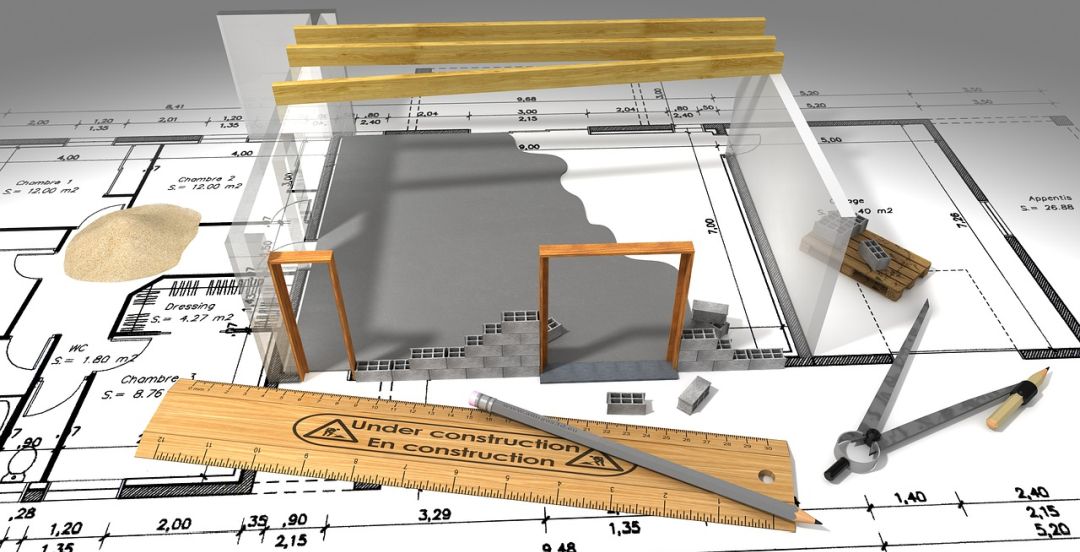Reducing the cost of new individual homes in Mediterranean areas: what role can ceiling fans play?
Building at the right price, while complying with regulations and providing occupants with the best possible thermal comfort conditions, is always a difficult exercise.
More specifically, for the Mediterranean coastline and hinterland (Mediterranean zones H3 and H2d respectively), the RE2020 regulation sets very ambitious targets that are not always easy to achieve.
Once the building envelope has been defined and complies with the target bioclimatic need (Bbio) value, the maximum degree-hour thresholds must be respected.
Degree hours and Cep nr: how to comply with maximum limits?
The maximum regulatory level of 1250 degree hours of summer discomfort is quickly reached[i]. To comply with the regulations, manufacturers have identified several solutions:
- High-performance ducted system
- Zone control
- Ceiling fans
The design office Expeb kindly agreed to examine the optimisations that could be put in place in the context of traditional single-family home projects.
Please note that this article will be updated as soon as new information becomes available. So don’t forget to sign up to our pro area to be kept informed of future updates.[ii].
What were our initial hypotheses?
We decided on an 88 m² detached single-storey house, located in zone H3. The Cep nr max is 45.1. The initial layout includes a ducted system with zone control and a thermodynamic water heater. The system appears to be compliant (Cep nr = 44.6). The study was carried out using Izuba’s Pléiades-Comfie software.
Simulations with ducting + zone control
We then added various Samarat ceiling fans, and played with the day, night and day & night modes.
Here is the corresponding summary table:
Basic system: ducted + zone control
| Number of Samarat ceiling fans | Surface area covered by ceiling fans[iii] | Mode | Cep nr | DH |
|---|---|---|---|---|
| 0 | Not applicable | Not applicable | 44,6 | 1063,5 |
| 1 | Useful surface area 17% | Day | 42,5 | 869,9 |
| 2 | Useful surface area 34 | Day | 40,9 | 720,3 |
| 3 | Useful surface area 51% | Day | 39,8 | 599,3 |
| 4 | Useful surface area 60% (maximum possible in day mode) | Jour | 39,2 | 521,7 |
| 4 | Useful surface area 68% | Day and Night | 42,9 | 875,0 |
| 4 | 40% usable area (maximum possible in night mode) | Night | 41,1 | 737,9 |
| 3 day zones, 3 night zones | 51% day area – 40% night area | 1 day set, 1 night set | 37,7 | 284,3 |
At this stage, the following elements appear:
- Ceiling fans have a very beneficial impact on Cep nr;
- The first ceiling fans have a very strong impact, while the latest ones can gain a few tenths of a point;
- Day mode is more favourable than night mode;
- The “day and night” mode is the most penalising;
- Setting up two sets of fans, one for daytime use, the other for night-time use, can help you to gain Cep nr points (in return for a large amount of equipment).

Simulations with ducting without zone control and with multi-split
We then studied different configurations with a view to finding an economic optimum.
| Systems installed | Number of ceiling fans | Surface area covered by ceiling fans | Mode | Cep nr | DH |
|---|---|---|---|---|---|
| Can be ducted without zone control | 3 Samarat | Usable surface area 51% | Day | 45,2 (non-compliant by a 10th of a point…) | 599,3 |
| Quadri-split | 3 Samarat | Usable surface area 51% | Day | 43 | 599,1 |
This table is particularly revealing of the savings that can be made by Samarat ceiling fans:
- If there is no zone control, the ductwork is no longer passable;
- Combined with a quadri-split, the Cep nr is perfectly respected with 3 Samarat ceiling fans.
To recap:
- A zone control system for a ducted unit costs around €1,500 including VAT, supplied and installed;
- A single-storey ducted unit costing around €6500 (incl. VAT) is supplied and installed;
- The cost of a ducted system for a single-storey house is around €8,000 including tax (additional cost of systems and masonry);
- A quadri-split costs around €5,000 inc. VAT (carbon impact to be verified, bearing in mind that ceiling fans have little impact).
For multi-storey houses, the solution with 3 Samarats in the day zone appears to be very economical: savings of around €3,000 (inc. VAT) by switching to a multisplit instead of a ducted system with zone control.
For single-storey houses, the savings represent €1,500 inc. VAT with 3 Samarats and a quadri-split solution instead of a ducted system with zone control.
BIn short, ceiling fans bring significant savings to the budget, and what’s more, with a solution that also reduces the impact of air conditioning (by using it less frequently, and by coupling it with a higher set point for the same level of comfort).[iv]).
The project owner will therefore save money during the construction phase, and gain even more during the operating phase.
Exhale ceiling fan: what’s the verdict?
Samarat ceiling fans are bladed units with a higher maximum airflow than Exhale fans (11,893 m3/h and 6,900 m3/h respectively). As such, they appear to perform better in RE2020. However, when it comes to real thermal comfort, the Exhale Fans ceiling fans are highly relevant. The diagrams below clearly illustrate the difference in operation between the two systems:
- the bladed fan produces high air velocities vertically above the blades; the velocities decrease as you move away from the cylinder vertically above the blades;
- the Exhale fan provides an air speed that is more evenly distributed in the room.

Other advantages make the Exhale fan even more suitable for single-family homes:
- Its design sets it apart from traditional ceiling fan solutions;
- The absence of blades makes it a safe system, even for children’s bedrooms with bunk beds.
| Systems installed | Number of ceiling fans | Surface area covered by ceiling fans | Mode | Cep nr | DH |
|---|---|---|---|---|---|
| Quadri-split | 4 Exhale | Usable surface area 51% | Day | 45,4 | 828,8 |
| Quadri-split | 3 Samarat day, 1 Exhale night |
Useful area 51% day Useful area 17% night |
1 day set, 1 night set | 45,6 | 732,3 |
| Quadri-split | 3 Samarat day, 1 Exhale night |
Useful area 51% day Useful area 17% night |
1 day set, 1 night set | 45,6 | 764,0 |
| Quadri-split | 3 Exhale day, 2 Exhale night |
Useful area 51% day Useful area 34% nightt |
1 day set, 1 night set | 45,1 | 709,0 |
The result is the same as in the first configuration, but with a higher number of devices.
In a single-storey house, the installation of 5 Exhale units, coupled with quadri-splits, improves DH, and represents a slightly higher cost than that of a ductable installation with zone control (around €1,000).
However, in a single-storey house, there is a slight saving of around €500 with an all-Exhale system.
Single-family homes: optimisation on a case-by-case basis
The analyses presented above show that economic optimisation is fairly easy to achieve with the Samarat ceiling fan, whether in a single-storey or multi-storey house.
As far as Exhale fans are concerned, their advantages in terms of air speed homogeneity and safety make them very attractive. In terms of economic optimisation, this is achievable in split-level house configurations.
Generally speaking, the study presented here shows that it is entirely appropriate to carry out studies on typical houses in order to find the best technical and economic solutions. Ceiling fans offer highly relevant solutions that use traditional techniques, are inexpensive to purchase and operate, and consume very little energy and carbon.
[i] See our article « Ceiling fans in homes: how to make the most of the RE2020 », which explains how degree hours are calculated.
[ii] We publish a quarterly newsletter to keep registered individuals and companies up to date with the latest technical information.
[iii] This is the percentage of the floor area occupied by rooms of a given type of use (day, night, day & night).
[iv] See our article « Ceiling fans and air conditioning: a marriage of convenience? »

Exhale, the first vortex-effect ceiling fan without blades
Are you a professional? We have a dedicated area for you.
Find Exhale Fans Europe on Linkedin

